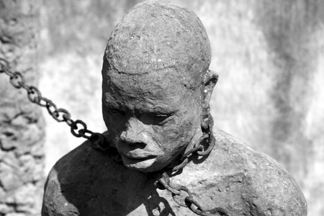Ending modern forms of slavery
 Slavery
is a black spot in human history. But in case you thought slavery is no
more, nothing could be more wrong. Various forms of slavery still exist,
but formal slavery where slaves were more or less auctioned has been
abolished. The UN has proclaimed several days to offer the International
Community an occasion to raise awareness on the issue of slave trade and
slavery. Slavery
is a black spot in human history. But in case you thought slavery is no
more, nothing could be more wrong. Various forms of slavery still exist,
but formal slavery where slaves were more or less auctioned has been
abolished. The UN has proclaimed several days to offer the International
Community an occasion to raise awareness on the issue of slave trade and
slavery.
They provide the necessary opportunity for recalling this sad episode
of history, to honour all the victims of four centuries of human
tragedy, but also those who opposed and triumphed over this "crime
against humanity". These commemorative days serve to deepen the
reflection on the contemporary consequences of this tragedy and its
implications in our society today, namely racism and racial
discrimination, intolerance, but also all the modern forms of slavery,
of exploitation and of human bondage.
Expectations
As an answer to the growing interest to and expectations generated by
the launching in 1994 of The Slave Route Project, UNESCO's General
Conference, proclaimed August 23 (today) as the International Day for
the Remembrance of Slave Trade and of its Abolition.
Approximately 11,863,000 Africans were shipped across the Atlantic,
with the death rate during passage reducing this number by 10-20
percent. As a result between 9.6 and 10.8 million Africans arrived in
the Americas. The slave trade between Western Africa and the America's
reached its peak in the mid-18th century when it is estimated that over
80,000 Africans annually crossed the Atlantic to spend the rest of their
lives in chains. Of those who survived the voyage, the final destination
of approximately 40% was the Caribbean Islands. Thirty-eight percent
ended up in Brazil, 17% in Spanish America and 6% in the United States.
About 500,000 Africans were imported into what is now the U.S. between
1619 and 1807 - or about 6 percent of all Africans forcibly imported
into the Americas.
Freedom
This date symbolises the fact that slaves were the principal actors
of their freedom. Effectively, the insurrection that occurred in Saint
Domingue (today Republic of Haiti and Dominican Republic), on the night
of August 22 and 23, 1791, irremediably affected the slavery system.
This revolt was the starting point to the transatlantic slave trade
abolition process. This date also pays tribute to the historic
resistance that leaded to the creation of the first black independent
State, the Republic of Haiti.
|

Slavery still exists: Pic courtesy: worldfuturefund.org |
While there are many memorials to the horrors of 18th century slave
trade, there are only a few memorials and exhibits that raise awareness
on modern day slavery. Among them are the International Slavery Museum
in Liverpool, England, Memorial to the Abolition of Slavery in the
French city of Nantes and the recently opened Memorial ACTE in
Guadeloupe. The UN recently commissioned the Ark of Return, a memorial
designed by American architect Rodney Leon, of Haitian descent, to
underscore the tragic legacy of the slave trade, which for over four
centuries abused and robbed 15 million Africans of their human rights
and dignity, and to inspire the world in the battle against modern forms
of slavery, such as forced labour and human trafficking.
Slavery in one form or another still exists, primarily due to human
trafficking where people are taken against their will to engage in
manual labour, prostitution or other illegal activity. The international
community must make concerted efforts to end this scourge which has
turned into a US$ 32 billion per year business. (Note that Human
trafficking differs from people smuggling, which involves a person
voluntarily requesting or hiring another individual to covertly
transport them across an international border on the payment of money,
usually because the smuggled person would be denied entry into a country
by legal channels. However, the same operators sometimes engage in both
businesses).
In 2008, the UN estimated that nearly 2.5 million people from 127
different countries were being trafficked into 137 countries around the
world. According to the International Labour Organization (ILO), more
than 20 million people around the world are victims of forced labour,
the vast majority of whom are women and children. The use of child
labour, including as child soldiers, continues to decline but there
still are millions of children who are forced to work against their
will, at the expense of their education.
There are 11.7 million forced labourers in Asia alone. Forced labour
and human trafficking is a global phenomenon, existing in every region
in the world and in every type of economy, whether industrialised,
developing or in transition. It can be found in both international and
domestic markets, in various sectors and industries - from apparel and
footwear manufacturing to agriculture, construction, electronics
manufacturing and many others. Estimates suggest that forced labour can
be 'found' in around 120 goods manufactured in nearly 60 countries - in
other words, some of these products have been made with the use of
forced labour and/or child labour.
Housemaids
The working conditions of some factories which produce goods on a
mass scale border on slavery. There are also instances where housemaids
(a legally recognized job) in the Middle East and certain other
countries are abused by their employers to the extent where they
virtually become slaves. There are many tragic stories of this nature.
The international community must act fast to curb human trafficking.
As US Secretary of State John Kerry said recently "right now, across the
globe, victims of human trafficking are daring to imagine the
possibility of escape, the chance for a life without fear, and the
opportunity to earn a living wage."
It is indeed difficult to escape the grip of human traffickers, but
Governments must intensify their crackdowns on traffickers and employers
of forced labour. Advanced technology including satellite and drone
technology must be used to track down instances of human trafficking.
Policing is also essential - for example, Uttar Pradesh in India plans
to have anti-human trafficking police stations and a special task force
to check the menace in the state.
All possible means must be employed to thwart the designs of human
traffickers who inflict the misery of modern forms of slavery on a
civilized world. |

